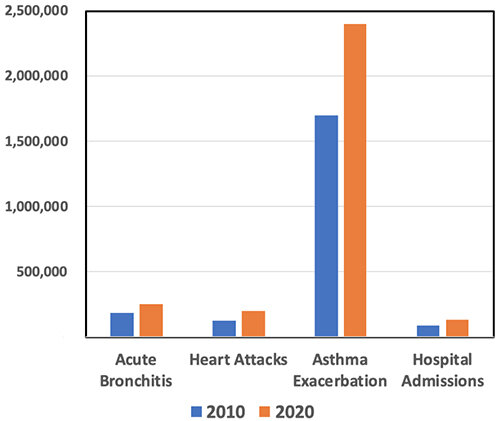By ROGER WARBURTON/ecoRI News contributor
 |
| The costs and benefits of the Clean Air Act, according to EPA data. (Roger Warburton/ecoRI News) |
The Clean Air Act of 1963 was one of the United States’ first environmental laws. It was a model for the world.
The Clean Air Act requires
the Environmental Protection Agency (EPA) to develop periodic reports that
estimate the benefits and the costs of the law, which include: improvements in
human health, welfare, and ecological resources; and the cost impact of the
act’s provisions on the U.S. economy.
 |
| The costs of investments required by the Clean Air Act. (EPA) |
The upfront costs were significant, amounting to $65 billion. The
costs were distributed across industries, as shown in the graph to the right.
Most of the costs ($28 billion) were invested in vehicles and fuel.
The electricity generation sector invested another $10 billion.
The electricity generation sector invested another $10 billion.
However, the benefits, which in 2020 are estimated to be nearly $2
trillion, are vastly greater than the $65 billion investment costs.
In fact, the benefits are more than 30 times the investment costs, according to a 2011 EPA report.
In fact, the benefits are more than 30 times the investment costs, according to a 2011 EPA report.
The benefits come from the many different impacts of the act, such
as the reduction in mortality from lowered particulate matter and lowered ozone
concentration. There are additional health benefits, which are summarized in
the next two graphs below.

By 2020, according to the EPA, the Clean Air Act will save more
than 230,000 lives annually. (Roger Warburton/ecoRI News)
If the Clean Air Act hadn’t been in effect, there would have been
2.4 million more serious asthma events, 255,000 more bronchitis attacks,
200,000 more heart attacks, and 135,000 more hospital admissions, according to
EPA data.
The Clean Air Act was passed 56 years ago to control air pollution
on a national level. It’s one of the country’s most influential environmental
laws, and one of the most comprehensive air quality laws in the world.
 |
| Negative health incidents that would have occurred had the Clean Air Act not passed, according to the EPA. (Roger Warburton/ecoRI News) |
In 1960, only six states had air pollution programs. By 1970, all 50 states had air pollution programs funded by the Clean Air Act.
Further amendments in 1990 addressed the problems of acid rain and ozone depletion.
The act was first amended in 1965, to set standards for the
emission of pollutants from automobiles.
One of the first, and most controversial emission standards, required the removal of lead from gasoline, which even in 1965 was recognized to be causing serious adverse health impacts.
The effort took more than two decades.
One of the first, and most controversial emission standards, required the removal of lead from gasoline, which even in 1965 was recognized to be causing serious adverse health impacts.
The effort took more than two decades.
The debate should sound familiar.
The automobile industry argued that it couldn’t meet the new standards and politicians expressed concern about the impact on the economy.
The automobile industry argued that it couldn’t meet the new standards and politicians expressed concern about the impact on the economy.
However, the stricter standards led to the creation of the
catalytic converter, which was a revolutionary development.

While the gross domestic product, U.S. population, and miles
traveled all rose significantly between 1980 and 2015, the aggregate emissions
of six common pollutants went down 65 percent. (EPA)
Since the 1963 law was passed, the emissions of volatile organic chemicals, carbon monoxide, nitrogen oxides, and lead have all been reduced by more than 90 percent. These reductions occurred despite a massive increase in the annual miles driven.
The removal of lead from gasoline saved lives by dramatically
reducing the lead levels in the blood of the U.S. population. It’s worth noting
that the level of lead in the average American’s bloodstream in 1976 would
today be considered as deadly.
 |
| As lead was removed from gasoline, the level of lead in the U.S. population’s blood also declined. (EPA) |
Children are especially sensitive to lead. When exposed to even
small amounts, they become inattentive, hyperactive, and irritable.
As lead levels increase, children experience learning and reading problems, delayed growth, impaired peripheral nerve function, and hearing loss. At high levels, lead causes permanent brain damage and, even, death.
As lead levels increase, children experience learning and reading problems, delayed growth, impaired peripheral nerve function, and hearing loss. At high levels, lead causes permanent brain damage and, even, death.
Pregnant women and their babies are also at risk from lead. Lead
that accumulates in the mother’s bones is released into her blood and enters
the blood of her developing fetus, where it can cause serious problems.
The Clean Air Act has reduced harmful pollutants from automobiles,
industrial smokestacks, and utility plants. Pollutants reduced include toxic
chemicals and particulate matter that cause asthma, emphysema, heart disease,
and other potentially lethal respiratory ailments.
Despite manufactured controversy and gloom-and-doom industry
lobbyists, the Clean Air Act continues to provide massive health, economic, and
environmental benefits that far outweigh the costs associated with controlling
life-threatening toxic pollution.
Roger Warburton, Ph.D., is a Newport resident.